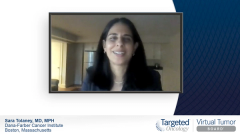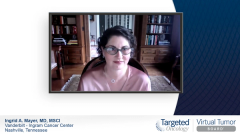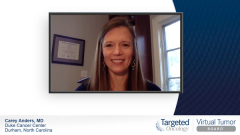
Case 1: Dual HER2-Targeted Therapy in HER2+ Early Breast Cancer
The panel of experts reviews the use dual HER2-targeted therapy in HER2+ breast cancer.
Episodes in this series

Sara Tolaney, MD, MPH: How about the use of dual HER2 [human epidermal growth factor receptor 2]–directed therapy? When do you consider not using dual HER2-directed treatment. For example, it sounds like formally we would give trastuzumab with pertuzumab. What would lead you to drop the pertuzumab? Carey, we can start with you.
Carey Anders, MD: This circles back to that critical decision: Are we going to do neoadjuvant or not? For the smaller-node negative tumors, I have relied on the APT [adjuvant paclitaxel-trastuzumab] regimen, which is essentially the Taxol for 12 weeks concurrent with trastuzumab. If I have a patient who has particularly an ER [estrogen receptor]–positive HER2+ breast cancer that’s stage I node negative, I will move forward with trastuzumab as a single biologic. I have also utilized in a patient a little more between the APT [adjuvant paclitaxel-trastuzumab] regimen and a neoadjuvant TCHP [docetaxel, trastuzumab, pertuzumab, carboplatin]. I will use—as you termed it, Sara—the Steven Jones regimen of Taxotere-cyclophosphamide with trastuzumab. Maybe a slightly larger tumor at surgery that we had expected. But utilize the dual biologic trastuzumab pertuzumab for node-positive disease or much larger node-negative disease.
Ingrid A. Mayer, MD, MSCI: I agree with that wholeheartedly. The folks for whom the dual-antibody blockade against virtue is important are the folks in whom the burden of disease is bigger, so lymph node positivity to me usually triggers the dual stuff. In the initial staging, even if you’re going to do neoadjuvant, it’s N0 if they don’t have a ginormous tumor. The same case that you presented, if the tumor was between 3 and 4 cm N0, I would have used TCH [docetaxel, carboplatin, trastuzumab], not necessarily TCHP [docetaxel, trastuzumab, pertuzumab, carboplatin], neoadjuvantly. I’m not comparing, but for discussion’s sake, if you look at the APHINITY data—the adjuvant trial exploring the addition of HP [trastuzumab, pertuzumab] to chemotherapy—the patients who truly benefited were the ones who had lymph node positivity. For the ones with lymph node negative disease, it didn’t make much of a difference to add the pertuzumab. That unfortunately brought the impact of the trial down because a boatload of patients in that trial were stage IIA and not stage IIB or stage III. In oncology we are increasingly shifting toward individualizing treatment and trying to do the Goldilocks approach, where you don’t treat too much and you don’t treat too little; you treat right. Being able to customize how much anti-HER2 therapy we’re going to give plays a role in that. If you’re going to skimp on the chemotherapy, I’d use dual blockade. If you’re not going to skimp on the chemotherapy, I’d reserve the pertuzumab for stage IIB and above.
Andrew Seidman, MD: A couple of years ago, I was asked to do a Grand Rounds Lecture. I decided to title lecture “Escalation, De-escalation, or Business as Usual.” I forced myself to think: Do we have to grab on to the latest shining object? Do we always have to add something or subtract something? Do old data still serve some patients well? We use what we call the Tolaney regimen. It’s not the ATP [adjuvant paclitaxel-trastuzumab] regimen. It’s the Tolaney regimen in New York. For patients with T1, B, C disease, multifocal A disease, N0, T2, Sara, you can remind us how well represented they were in your trial, particularly the T2 young group if you consider those 2 factors. I worry about de-escalation in that group.
I agree with everything that Carey and Ingrid said. I can’t help thinking about this subject. This is being recorded within a week of the tragic loss of José Baselga, whose leadership and contribution to this story—the APHINITY trial and beyond—inform how we care for patients. The APHINITY data for me, building on Jose’s prior CLEOPATRA data, were not quite as robust in terms of the benefits. I think of the dual-HER2 inhibition primarily in higher-risk patients. As Carey and Ingrid have said, node-positive patients.
Sara Tolaney, MD, MPH: Thanks very much, Andy. I certainly agree. Just to return to your comment about the APT [adjuvant paclitaxel-trastuzumab] study and the smaller tumors. As you noted, there were very few patients with tumors between 2 and 3 cm. APT [adjuvant paclitaxel-trastuzumab] impacts only 36 patients, or about 9% of the 406 patients in that trial. Unfortunately, we don't have much data about addressing patients with these smaller node-negative cancers with a de-escalated chemotherapy backbone. Although as we’ll talk about shortly, we will gain more data in this space. I too have felt a little uncomfortable about just using TH [paclitaxel, trastuzumab] in my 2- to 3-cm node patients because of limited data there.
Transcript edited for clarity.














































